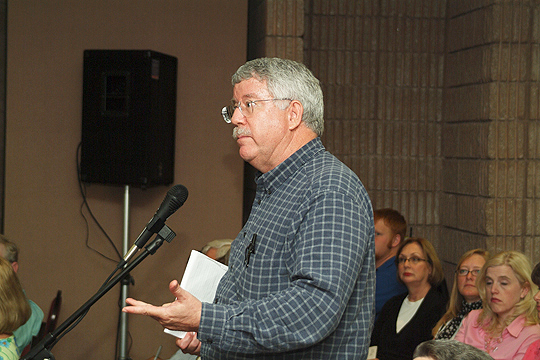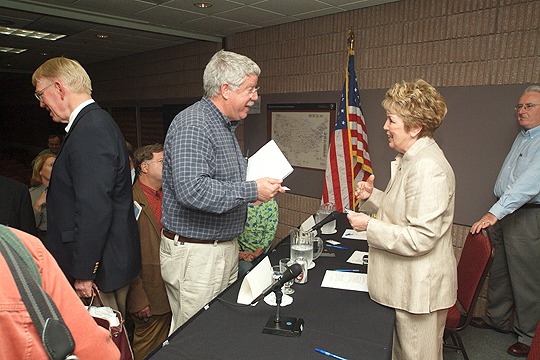National Park Service Listening Session: Gatlinburg, Tennessee
Crater Lake Institute
March 14, 2007
Subject: Gatlinburg listening session
By OWEN HOFFMAN
I attended yesterday’s NPS first “listening session” on the National Park Centennial Initiative in preparation for the 2016 NPS centennial. The meeting was held at the Mills Auditorium near the Gatlinburg Convention Center in Gatlinburg, TN. For those of you not familiar with the area, Gatlinburg is situated right outside the northern border of the Great Smoky Mountains National Park and is a major commercial tourist center and gateway community.
 |
|
Owen Hoffman at the Gatlinburg Listening Session Photo by Mike Kesselring |
Despite the very short public notice for this meeting given in the local media, there were about 300 persons in attendance. However, approximately 40 were plain clothed superintendents from other parks who were attending because this “listening session” coincided with a special conference for Southeast regional park superintendents. These high-level NPS employees mostly stood in the back of the room. The room was filled to capacity.
Most of the NPS uniformed staff who were in attendance were from the Great Smoky Mountains National Park, with the exception of Southeast Regional Director Patricia Hooks, who was in attendance and in uniform.
Secretary of the Interior Dirk Kempthorne and NPS Director Mary A. Bomar, along with GSMNP Superintendent Dale Ditmanson, facilitator Steve Whiteshell, Superintendent of San Antonio Mission on detail for this project, and a court reporter were at the front of the room. They assumed the role of official “listeners.” Their opening comments were cordial and very brief.
Contrary to what I had been informed of prior to the meeting via our CNPSR listserve, the NPS “listening session” format was not one of multiple workstation break-out sessions. Instead, it resembled more of a town-hall meeting in which each pre-registered attendee desiring to make a statement was given 2 minutes to speak. Steve Whiteshell, enforced the time limits.
It was readily apparent to all attending that Director Bomar and Secretary Kempthorne made a dedicated effort to listen to each and every commentator. They often responded directly to the comments made. I was impressed with their demeanor and their exceptional demonstration of listening skills.
I was also impressed with the general underlying theme of most commentators, which was “Keep parks unimparied for the enjoyment of future generations.” “Keep privatization and commercialization out of our parks, there’s enough of that in Gatlinburg!” “Parks are primarily there for inspiration, contemplation, education and recreation and belong to all of the public.” “The NPS needs to minimize conflicts between the primary objectives of preservation and protection of cultural and natural resources and while providing access to park visitors.”
Three speakers were NPCA staffers representing the NPCA Southeast Region. These included Don Barger, NPCA regional representative, from Norris, TN, Emily Jones, and Gregg Kidd. Both Director Bomar and Secretary Kempthorne acknowledged the presence of NPCA at this meeting and emphasized that the NPS and NPCA had a tradition and a legacy of a close working partnership.
Secretary Kempthorne made it a point to state that at a previous meeting, NPCA promised him that their organization would stand up and applaud if the Bush Administration would be able to raise an additional $250 million for our parks. Kempthorne then countered that the Bush Administration was developing an increased budget inititiative for FY’08 that would increase park funding by $258 million.
During last night’s meeting, the educational value of national parks and the educational role of the national park ranger was given a high priority by many speakers, and this value was acknowledged by those in sitting in front of the room who were charged with doing the “listening.” The principal of the Gatlinburg elementary school was in attendance. He and a group of his students had been on a hike earlier in the day with Sec. Kempthorne. They were in attendance to support the educational values of the park and the importance of the park for their school curriculum.
Because the format of this meeting was organized for a steady sequence of input from registered participants to give 2 minutes of oral comment, there was not opportunity for open discussion nor debale of details of the president’s 2008 budget initiative, nor was their an opportunity for debate or elaboration on specific issues. The attendees were encouraged to follow-up with written comments and to use the NPS web site reserved for online comment at www.nps.gov/2016.
The overall atmosphere of this meeting was definitely upbeat and a most definite improvement over what I witnessed one year ago in Sevierville, TN when I attended an ill-fated and poorly organized NPS “listening session” that was intended to introduce the public to the details of the proposed draft re-write of the NPS Management Policy Guidelines. That meeting was intended for the NPS to do the talking and for the public to do the listening. It didn’t go over very well at all.
Surprisingly, at last night’s meeting, I did not hear much from pro-development interests, although there were many in attendance representing the interests of local gateway communities. A few mentioned the historic value of the controversial North Shore Road on the North Carolina side of the park and were long-time supporters for its completion. Lynn Faust of Knoxville, TN made an impassioned plea for the preservation/restoration of the historic developments and lodge inside the park at Elkmont, including the need to restore the now demolished Wonderland Hotel.
One mountain biker made a plea for more mountain bike access inside the Great Smoky Mountains National Park. He received a direct acknowledgement from Sec. Kempthorne that President Bush himself is a mountain biker and would be sympathetic to his request. The mountain biker claimed to be a conservationist and preservationist, and often performs volunteer trail maintenance when riding on trails.
There were at least two active members of the CNPSR present, Warren Bielenberg, and myself. Warren stated that without more permanent NPS positions, increasing park staffing through additional volunteers and more seasonals amounts to even more work for existing staff who must recruit, train, and supervise a continually changing cadre of part-time personnel. Warren said that this would be most definitely the case with the proposed increase of 300 seasonals.
Secretary Kempthorne said that the proposed increase was not 300 additional seasonals but 3000. Kempthorne promised that increases would also occur among NPS permanent positions as well.
I was speaker number 25. I found myself totally unprepared to deliver my miriad of thoughts within a 2 minute time period. In my preparations to attend this meeting, I had no idea what was going to be the operational format for public input. So, when called to the mike, I had to think very fast and prioritize my comments, taking into consideration all that was said by the 24 who spoke before me.
I basically made a plea for the US Government to support basic park operations directly and that parks should not have to rely on private funding to operate. After all, the US Natonal Parks are for all Americans.
I voiced my concern that when visiting parks in recent times, it is very rare to find a national park ranger. We see mostly volunteers and natural history association employees in our park visitor centers. As a park visitor, we seldom see anyone in the park wearing the uniform of a real ranger, unless it happens to be a law enforcement ranger inside a prowl car.
I made a plea for the protection of “the other half of the park,” and mentioned the importance of the NPS taking a leadership role in promoting the aethetic awareness and cultural values of a dark and starry night. I made a brief plea for consideration of an NPS Ranger Reserve composed of past NPS employees who are available and would eagerly serve the NPS in times of special need, if asked.
As I talked, I observed Mary taking notes. As I finished, I was amazed at how stressful and difficult it was to make an articulate presentation in just a 2 minute period of time.
Park staff, Director Bomar, and Secretary Kempthorne remained in the room for almost an hour after the conclusion of the listening session. In all, 40 individuals had spoken, and no additional persons came forward at the conclusion of nearly 2 hours of public commentary.
My overall impression of this meeting was positive, but I felt somewhat concerned that there was no real opportunity to get into details. Certainly Secretary Bomar and Secretary Kempthorne, and all others in attendance at this meeting, got the message loud and clear: that there are many Americans who value our parks highly and that we want these special places kept unimpaired for future generations to come.
It was only today that I read the official NPS brochure distributed from last night on the National Park Centennial Initiative having to do with “Signature projects and programs.” In this brochure it is firmly stated that such projects will:
- rely on leveraging of philanthropic, partnership, and government investments for the benefit of the parks and the park visitor
- provide for a margin of excellence,
- capture the imagination of the public,
- secure at least a 1:1 philanthropic match,
- use current staffing, unless additional staff is provided through endowed positions or partners
- be sustainable in design, material, and location
Among the items stated above, I am most concerned about item (5.) above. This written statement appears to be in conflict with the answers given to Warren Bielenberg by Secretary Kempthorne. It also reminds me of the situation currently faced by major urban symphony orchestras whose principal chairs are filled through endowments from private donations.
I hope you my write-up of impressions of this first “listening session” to be of interest.
Owen
Note: We would like to thank Owen, a board member of the Crater Lake Institute, for taking the time and effort to attend this meeting and for making a contribution to the proceedings.
Other pages in this section


